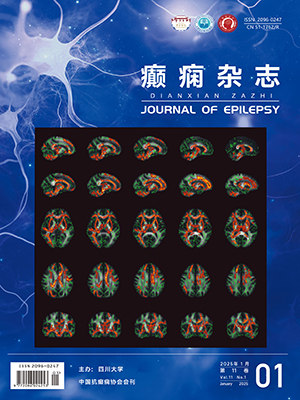| 1. |
https://www.ema.europa.eu/en/medicines/human/referrals/valproate-related-substances. Accessed 1 Dec 2019.
|
| 2. |
Brigo F, Igwe SC, Lattanzi S. Ethosuximide, sodium valproateor lamotrigine for absence seizures in children and adolescents. Cochrane Database Syst Rev, 2019, 2: CD003032.
|
| 3. |
Marson AG, Al-Kharusi AM, Alwaidh M, et al. The SANAD study of effectiveness ofvalproate, lamotrigine, or topiramate for generalised and unclassifiableepilepsy: an unblinded randomised controlled trial. Lancet, 2007, 369: 1016-1026.
|
| 4. |
Mazurkiewicz-Bełdzińska M, Szmuda M, Matheisel A. Long-term efficacy of valproate versus lamotrigine in treatmentof idiopathic generalized epilepsies in children and adolescents. Seizure, 2010, 19: 195-197.
|
| 5. |
Berkovic SF, Knowlton RC, Leroy RF, et al. Placebo-controlled study oflevetiracetam in idiopathicgeneralized epilepsy. Neurology, 2007, 69: 1751-1760.
|
| 6. |
French JA, Krauss GL, Wechsler RT, et al. Perampanel for tonic-clonic seizures in idiopathicgeneralized epilepsy. Neurology, 2015, 85: 950-957.
|
| 7. |
Miró J, Aiguabella M, Veciana M, et al. Low-dose sodium valproate in the treatment of idiopathic generalized epilepsies. Acta Neurol Scand, 2014, 129(5): e20-23.
|
| 8. |
Marson A. Levetiracetam Inferior to Valproate in Generalized. Unclassif Epilepsy Epilepsia, 2019, 60(1): 1-248.
|
| 9. |
Pickrell WO, Lacey AS, Thomas RH, et al. Trends in the first antiepileptic drug prescribed for epilepsy between 2000 and 2010. Seizure, 2014, 23: 77-80.
|
| 10. |
Paulson GWPR. Teratogenic effects of anticonvulsants. Arch Neurol, 1981, 38: 140-143.
|
| 11. |
Tomson T, Battino D, Bonizzoni E, et al. Declining malformation rates with changed antiepileptic drug prescribing. Neurology, 2019, 93: e831-e840.
|
| 12. |
Bromley RL, Weston J, Marson AG. Maternal use of antiepileptic agents during pregnancy and major congenital malformations in children. JAMA, 2017, 318: 1700-1701.
|
| 13. |
Bromley RL, Calderbank R, Cheyne CP, et al. Cognition in school-age children exposed to levetiracetam, topiramate, or sodium valproate. Neurology, 2016, 87: 1943-1953.
|
| 14. |
Bromley RL, Baker GA, Clayton-Smith J, et al. Intellectual functioning in clinically confirmed fetal valproate syndrome. Neurotoxicol Teratol, 2019, 71: 16-21.
|
| 15. |
Bromley R, Weston J, Adab N, et al. Treatment for epilepsy in pregnancy: Neurodevelopmental outcomes in the child. Cochrane Database Syst Rev, 2014, 10: CD010236.
|
| 16. |
Cohen MJ, Meador KJ, May R, et al. Fetal antiepileptic drug exposure and learning and memory functioning at 6 years of age: The NEAD prospective observational study. Epilepsy Behav, 2019, 92: 154-164.
|
| 17. |
Bromley RL, Baker GA, Meador KJ. Cognitive abilities and behaviour of children exposed to antiepileptic drugs in utero. Curr Opin Neurol, 2009, 22: 162-166.
|
| 18. |
Christensen J, Grnøborg TK, Srøensen MJ, et al. Prenatal valproate exposure and risk of autism spectrum disorders and childhood autism. JAMA, 2013, 309: 1696-1703.
|
| 19. |
Veroniki AA, Rios P, Cogo E, et al. Comparative safety of antiepileptic drugs for neurological development in children exposed during pregnancy and breast feeding: a systematic review and network meta-analysis. BMJ Open, 2017, 7: e017248.
|
| 20. |
Edey S, Moran N, Nashef L. SUDEP and epilepsy-related mortality in pregnancy. Epilepsia, 2014, 55(1): e72-e74.
|
| 21. |
Mawer G, Briggs M, Baker GA, et al. Pregnancy with epilepsy: obstetric and neonatal outcome of a controlled study. Seizure, 2010, 19: 112-119.
|
| 22. |
Tomson T, Battino D, Bonizzoni E, et al. Comparative risk of major congenital malformations with eight different antiepileptic drugs: a prospective cohort study of the EURAP registry. Lancet Neurol, 2018, 17: 530-538.
|
| 23. |
PRAC recommends new measures to avoid valproate exposure in pregnancy. https://www.ema.europa.eu/en/news/pracrecommends-new-measures-avoid-valproate-exposure-pregnancy. Accessed 15 Nov 2019.
|
| 24. |
Aaberg KM, Surén P, Sraas CL, et al. Seizures, syndromes, and etiologies in childhood epilepsy: the International League Against Epilepsy 1981, 1989, and 2017 classifications used in a population-based cohort. Epilepsia, 2017, 58: 1880-1891.
|
| 25. |
Benbadis SR. Practical management issues for idiopathic generalized epilepsies. Epilepsia, 2005, 46: 125-132.
|
| 26. |
Stephen LJ, Harden C, Tomson T, et al. Management of epilepsy in women. Lancet Neurol, 2019, 18: 481-491.
|
| 27. |
Beghi E, Giussani G, Grosso S, et al. Withdrawal of antiepileptic drugs: guidelines of the Italian League Against Epilepsy. Epilepsia, 2013, 54(1): 2-12.
|
| 28. |
Wilson RD, De Bie I, Armour CM, et al. Joint SOGC-CCMG opinion for reproductive genetic carrier screening: an update for all Canadian providers of maternity and reproductive healthcare in the era of direct-toconsumer testing. J Obstet Gynaecol Canada, 2016, 38: 742-762.
|
| 29. |
Epilepsies: diagnosis and management (2019) https://www.nice.org.uk/guidance/cg137. https://www.nice.org.uk/guidance/cg137. Accessed 1 Dec 2019.
|
| 30. |
Lamberink HJ, Otte WM, Geerts AT, et al. Individualised prediction model of seizure recurrence and long-term outcomes after withdrawal of antiepileptic drugs in seizure-free patients: a systematic review and individual participant data meta-analysis. Lancet Neurol, 2017, 16: 523-531.
|
| 31. |
Tomson T, Battino D, Bonizzoni E, et al. Withdrawal of valproic acid treatment during pregnancy and seizure outcome: observations from EURAP. Epilepsia, 2016, 57: 173-177.
|
| 32. |
Koubeissi M. Levetiracetam: more evidence of safety inpregnancy. Epilepsy Curr, 2013, 13: 279-281.
|
| 33. |
Meador KJ, Baker GA, Browning N, et al. Breastfeeding in children of women taking antiepileptic drugs: Cognitive outcomes at age 6 years. JAMA Pediatr, 2014, 13: 279-282.
|
| 34. |
Alliance G. Understanding genetics: a district of Columbia guide for patients and health professionals, vol 1. Genetic Alliance, Washington, DC, 2010: 67-72.
|
| 35. |
Auvin S, Chhun S, Berquin P, et al. Aggravation of absence seizure related to levetiracetam. Eur J Paediatr Neurol, 2011, 15: 508-510.
|




